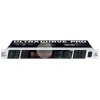I think that a preamp, EQ (parametric or graphic), compressor, expander, limiter, gate, and MAYBE only a smidge of plate reverb - will provide optimum results. The Behringer DEQ-2496 does most of these processing functions if you set the device for split channel operation. They sell for ~$350 new; I got one at a consignment shop used for $150.
A fine pedal from Eventide to use on this setup. But it isn't a balanced in/balanced out - is it? Might be a problem. If I were to use a reverb; I would get an Alesis Miniverb or a Lexicon 200 - perhaps. The reason I don't use a reverb unit, is that I would need a small mixer to make it work. I would need a send/return bus so in the mixer itself so that I could balance the dry/wet amount of reverb from that device.
Without using a 'verb; I can just link the mic to the preamp - the preamp out to the left input side of the DEQ - the left output side of the DEQ into the right input side of the DEQ - the output of the right side of the DEQ to the input of the BBE maximizer - and the BBE maximizer out to the radio mic input.
Remember - that the DEQ is running in the 'split channel function' - so it acts as two separate processors.
You might want to just use the mic and the preamp into the radio first - and get it right before trying to use the effects. If you are going to use your pedal board with a balanced mic; then you will need to get the wiring right from the mic preamp to the next piece of gear. Remember that a lot of pedals aren't known for being noise-free! You might introduce a LOT of noise to the broadcast sound. That is why a balanced in/out chain is best; but not necessary so long as too many devices in line aren't involved.
At this point - if any hum occurs in the sound - then lifting/adding a ground wire before it enters the radio may be necessary. The balanced XLR coming from the ART preamp will need to have the "-" and ground wire tied together. If hum is happening here; then disconnect the "-" from the ground wire and use the "-" to make the mic work WITHOUT getting hum. Trial and error - if necessary...
Since you are using the SM-58; you will need some patience to get the equalization dialed in. Be careful of too much midrange; less is more. That is - there is already a lot of midrage 'peaks' in the SM-58; so it can overwhelm the rest of the frequencies you are working with. High freqs might need some tasteful work. Bass should be smooth and not frumpy.
The only real way to know what you sound like is to have a friend that you talk to on the radio to help guide the process of final tone adjustments. It would help immensely if he is using a full-range two or three way speaker on his end. It wouldn't hurt for you to do the same thing; as this can help one's receive substantially as well. Just plug it into the external speaker jack on the back of the radio. It is worth the trouble; not much trouble at all. Some will go as far as using a line transformer from the external speaker output of the radio - to an amp that has a graphic 10 band EQ and then to a 3 way speaker. Yes; you can do this too...
Making a wind screen from some panty hose and a hoop will tame sibilance, wind blast, and give you an overall better sound. It is NOT the same as a foam windscreen; the SM-58 already has a piece of foam inside it. The commercial-made 'pop' screen/unit will cost about ~$20 from Guitar Center, if you don't want to brew your own. It is a low-tech device that can equalize sound pressure that yields high-tech results...
Another major improvement -IMO- can be done by using a large capsule single cardioid condenser microphone - like the MXL brand. They are inexpensive vs performance, sensitive, ultra-flat response is easier to equalize, and your ART mic preamp already has phantom power to operate it built right in. I got my MXL V88 at a consignment shop for ~$80/used including the suspension.
Just imagine what else you can do!
Pictured:
MXL V88 w/suspension
Behringer DEQ 2496
Commercial made 'Pop' screen



